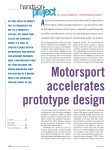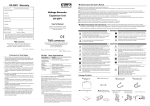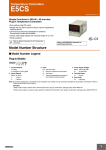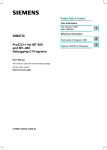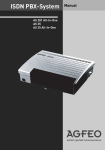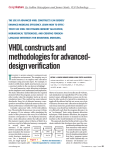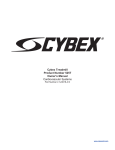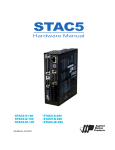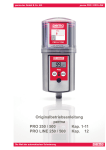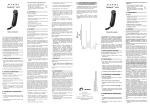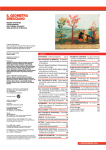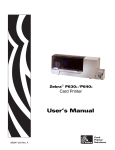Download Embedded Linux steals design wins
Transcript
designfeature By David Marsh, Contributing Technical Editor LINUX SEEMS TO HAVE BEEN THE “NEXT BIG THING” IN EMBEDDED SYSTEMS FOR YEARS. FINALLY, IT IS BEGINNING TO PENETRATE THE EMBEDDED SYSTEMS MARKET. VENDORS KEEN TO PROMOTE NEW MARKETS FOR THEIR SILICON NOW DRIVE INVESTMENT IN THE OS. SO, HOW EASY IS IT TO GET STARTED, AND HOW USEFUL IS IT? Embedded Linux steals design wins t a design review meeting five short years ago, my suggestion to consider Linux for an embedded system’s user interface and supervisory control met with a lukewarm response. Objections ranged from Linux’ inability to respond to real-time events, through concerns about software support within the open source community, to plain fear of the unknown—and the group eventually chose Windows CE. Back then, it’s fair to say that no derivatives of mainstream operating systems properly suited embedded development, with the result that most designs employed proprietary solutions such as QNX Neutrino or Wind River’s VxWorks. Meantime, the mainstream commercial and opensource communities have been busy adopting their core software architectures to suit small-footprint embedded systems—with the result, for example, that at last February’s 3GSM World Congress, industry giants such as Infineon, Philips, Samsung, and STMicroelectronics announced cell phone products that use Linux. Elsewhere, Freescale’s software arm Metrowerks offers automotivestrength Linux, primarily for in-car entertainment applications. And just last month, Xilinx announced a Linux port for its freely downloadable Webpack FPGA development environment, signalling the OS’s increasing acceptance within the engineering fraternity. So just how useful is Linux for embedded development and—equally importantly—how easy is it to get started? First off, it’s essential to differentiate between “hard”real-time operating systems that guarantee no missing deadlines and where timelines are exactly A 20 edn europe | June 2005 known, and “soft” real-time systems that, on average, perform tasks within a specified timeframe. Environments such as QNX, VxWorks—and a host of others, such as the Realogy suite from LiveDevices and Volcano’s automotive networking series—tackle mission-critical applications where fully deterministic response is essential (Reference 1). But as EDN’s Warren Webb recently reported, there are a number of commercial Linux products that target real-time needs, such as BlueCat Linux from LynuxWorks that complements its LynxOS, and the forthcoming Red Hat Embedded Linux, a cooperative effort from Linux stalwarts Red Hat and the biggest commercial RTOS vendor—Wind River—that harmonises Linux and VxWorks (Reference 2). Proof that these developments mean business comes from recent announcements such as General Dynamics Advanced Information Systems’ selection of LynuxWorks’ LynxOS-178 safety-critical RTOS for the US Army’s future combat systems (FCS) infrastructure. While such systems are Linux–compatible, they inevitably employ proprietary software to fulfil customer needs. For example, MontaVista’s modifications to the Linux kernel for its carrier-grade product add numerous pre-emption points to improve worst-case latency from ⬎100 msec to ⬍1 msec to suit use within telecoms infrastructures. Alternatively, RTLinuxPro from FSMLabs runs Linux as an idle thread under supervision from a hard real-time OS core that guarantees worst-case interrupt latencies of 13 sec on a typical x86 platform, while permitting seamless access to the Linux environment. European interest comes from Italian software www.edn-europe.com designfeature Embedded Linux Figure 1 The Stamp board from Analog Devices enables Linux development via a 500 MHz Blackfin microcontroller and 128 Mbytes of SDRAM. developers Koan, whose Klinux uses the real-time application interface (RTAI) kernel extensions from the RTAI Project at the Polytechnic of Milan’s aerospace engineering department to furnish hard real-time response. Available under royalty-free open-source conditions, Koan specialises in porting its system to processors including x86, ARM, PowerPC, and Xscale architectures, principally for use within industrial controls. Back in the consumer space, the spate of infotainment and telephony application announcements signals a trend for far more widespread embedded Linux adoption within devices that impose less severe demands on mission-critical sturdiness and real-time response. Of course, Linux already has an enviable reputation for reliability and security that helps explain its recent choice for a joint venture between mobile phone operator Orange and STMicroelectronics, where the OS runs a secure electronic cell phone payment application on STM’s ARM-based Nomadik processor. But Linux’ traditional response-time tardiness has been a barrier for many applications, which has been due to the original kernel’s non-pre-emptive design—where running tasks suspend interrupts—along with the use of a fairness algorithm for its scheduler that guarantees all tasks 22 edn europe | June 2005 a slice of processor time, regardless of priority considerations. This kernel also depends on page-swaps between tasks, which makes it impossible to accurately predict timing in systems that must accommodate asynchronous events. It also requires a memory-management unit (MMU) for memory protection and to facilitate multitasking. Today’s version 2.6 of the kernel includes enhancements to reduce latency along with many embedded-friendly features, including the option to build smallfootprint kernels for devices that don’t require user interfaces. Included in kernel releases from the interim version 2.5, the heart of the system is the so-called O(1) scheduler that adds kernel pre-emption, task priorities, and a dedicated time slicer. Mark Spencer, president of Linux-based telephony-systems builder Digium, reports that the OS’s performance is fine for soft real-time applications without additional kernel modifications: “Most modern PC platforms can handle as many as 1,000 hardware interrupts/sec, which is adequate for the time-divisionmultiplex busses at the core of Digium’s Asterisk system,” he says. He considers that one of Linux’ key advantages is its ability to scale from tiny embedded platforms to supercomputers and parallels its development with that of the PC: “In the beginning, PCs just ran word processors and spreadsheets, but they soon began to displace minicomputers and dominate the computing landscape. Linux is becoming similarly pervasive, with products now appearing in hugely diverse application areas.” Spencer observes that Digium’s continuous development of its open-source Asterisk offering, which the company can also license to third parties for proprietary software development, typifies the Linux commercial fraternity’s business model: “We’ve just launched Asterisk Business Edition and are working on more PBX infrastructure hardware, including an echo cancellation card,” he says. Another hardware consideration is Linux’ requirement for 32-bit machines. There is a 16-bit project that targets 8086-type architectures at http://elks. sourceforge.net, but with the availability of 32-bit chips such as Atmel’s AT91SAM7S family of ARM7-based Flash microcontrollers costing around $3 in volume, it’s pointless pursuing 16 bits for anything other than historical curiosity. Of course, Linux’ own history of development on 386 machines means that it’s easy to port into the 386 embedded space. But there’s also widespread support for ARM and PowerPC architectures, along with various projects that include www.edn-europe.com designfeature Embedded Linux target machines such as MIPS and 32-bit Renesas Super-H devices that include MMUs. The uClinux project (www. uclinux.org) makes it possible to run Linux on machines that lack MMUs, which is significant for the embedded space—where there’s often little demand for multitasking. Unlike many other Linux projects that currently appear fairly dormant, uClinux is definitely alive and well. In fact, kernel version 2.6 includes features from this project, with the result that it’s now possible to run the OS on MMU-less chips, such as Analog Device’s Blackfin, the ARM7TDMI, Freescale’s 68k/ColdFire and QUICC products, Intel’s i960, and NEC’s V850E. If you must have 16 bits, there’s even an active project for the H8S/2100 from Renesas (see http:// sourceforge.net/projects/h8-uclinux/). For engineers interested in applying Linux for applications as diverse as embedded controls and infotainment consoles, the recently released ADSP-BF533Stamp development kit from Analog Devices (ADI) makes interesting news. For less than $200, the product comprises a target board, a CDROM that contains the uClinux software, and a universalinput power supply—just add a standard straight-through serial cable and a host PC and the system is complete. The board accommodates a single ADSP-BF533 Blackfin 500 MHz processor along with a seemingly massive 128 Mbytes of SDRAM that’s arranged in four banks of 16⫻4 (Figure 1). This memory complement gives software writers sufficient latitude for application development at a time when multimedia phones are demanding as much memory as some PCs. For example, Samsung has just announced a 4 Gbit flash memory that packs four 1-Gbit die into an 11⫻13 mm package. The 1.8V device sustains data reads at 108 Mbytes/sec—four times faster than conventional NAND Flash devices—and writes at 10 Mbytes/sec, which is over 60 times faster than standard NOR Flash. The company plans mass production starting this July. The Stamp board accommodates 4 Mbytes of Flash together with a CPLD that expands the processor’s asynchronous memory space to suit this maximum amount of Flash. Various peripherals, such as a 10/100 Mbit/sec Ethernet port, appear within the processor’s asynchronous memory-map space. Other hardware highlights include three pushbutton switches and LED indicators that the CPLD can map into GPIO space or disconnect, and a multilevel switchmode power supply that displays the capabilities of ADI’s ADP3025 controller chip. Two headers that allow access to the Blackfin’s and the CPLD’s JTAG interfaces complement the normal range of headers that access the microcontroller’s peripherals (Figure 2). These peripherals include two serial ports, an SPI port, a parallel-port/GPIO interface, three timers, a real-time clock, and an infrared device interface. These features fit onto a four-layer board that measures 178⫻127 mm. An ADC daughter-board is available, and hardware now under development (for which schematics are already freely available) includes an audio codec card and a pair of video encoder/decoder cards. The CDROM contains the system’s LOW-COST DEVELOPMENT SYSTEMS documentation, including schematics All of this may sound just great. Howand CPLD files, and various software ever, the available choices make getting components. A 130-page user manual started with Linux a nontrivial exercise. that includes sections from Analog As all embedded development requires a Devices and Arcturus Networks introhost machine, it’s next-to-essential to duces uClinux and documents the have a desktop Linux installation (see Stamp board. It includes some tutorial sidebar “Is Linux fit for prime time?”). material but is currently in the pre-beta If this choice is complex, choosing an stage (release 0.5.4); for updates, check embedded platform is even more diffithe user group pages at http:// cult. For instance, a search for embedded blackfin.uclinux.org, which is also the English-language Linux at www.linux.org portal for support issues. The CDROM’s returns no less than 27 distributions software content includes pre-built kerfor all platforms. As for the desktop ennel images and the source code, the vironment, it’s perfectly feasible—and toolchain ports for the Blackfin, a free within the spirit of the Linux communidistribution of JTAG tools, the U-Boot ty—to download freely available files loader, and a Blackfin port of the Cygwin and compile your own installation. Enenvironment. A single-sheet quick-start gineers with less time and more immediguide satisfies users anxious to make ate focus are more likely to benefit from something happen. The first task is ready-made development platto establish PC-to-board forms, and again there’s a wide communications using, for choice. For example, Koan ofinstance, HyperTerminal. fers a start-up kit that includes Follow the few instructhe software, documentation, tions and the board powers and the company’s developup, runs through some ment environment/toolbox memory check routines, from €299. At the opposite and defaults to boot the end of the spectrum, Arcturus kernel from onboard Flash. Networks—the professional The uClinux command developer of uClinux—offers shell screen duly appears a reference platform for resiwithin the HyperTerminal dential gateways and routers, window. along with complete develTo avoid the necessity of opment kits for Atmel’s installing Linux on the Figure 2 AT91-ARM7TDMI as well as host—in the case of this for Freescale’s ColdFire and evaluation, a Windows XP DragonBall architectures at Headers provide access to all peripherals while offering JTAG connectivity Professional machine runprices that span $495 to $1295. to programme the ADI Stamp board’s Flash. ning SP2 on an NTFS- 24 edn europe | June 2005 www.edn-europe.com designfeature Embedded Linux IS LINUX FIT FOR PRIME TIME? As the main text asserts, embedded Linux developers require a desktop instance. And while Linux gurus promote their favourite installations, newcomers often wonder what’s different about packages from mainstream vendors such as Mandriva (formerly Mandrake), Red Hat, Slackware, and SuSE—especially as it’s possible to download and build an installation from, for instance, Debian (www.debian.org) or Fedora (www.fedoraproject.org ) for free. Interested users should also check out the lesser-known Gentoo (www.gentoo.org), a Linux flavour that’s expressly tuned for scalability. But first-time users need determination to build their own systems from Web resources, whereas for typically less than €100, commercial distributions provide a package that’s guaranteed to install relatively quickly, together with support documentation that’s often quite good. All such distributions contain similar core components and mainly differ in the additional software that comes in the bundle—such as graphical set-up tools that augment traditional command-line configuration commands. But it’s worth checking which kernel version the distribution includes, although the latest release isn’t necessarily the most stable—hence commercial users typically recommend using one that’s a few issues old, unless it’s known to have serious flaws. Another point that’s worth considering is the distribution’s ability to detect hardware. Although the major vendors have improved their products’ installation routines significantly in recent years, experience suggests using a PC that’s as standard as possible—not so long ago, USB support was 26 edn europe | June 2005 flaky, and it’s only in the last month that an everyday Windows-PC utility such as CDROM/DVD burning software from Nero (Germany’s world leaders in PC optical-writer software) has become available. Notebook-PC support is supposedly available, too, but I haven’t yet dared to test this on a brand-new Dell Inspiron that (astoundingly) lacks reinstall disks for its Windows XP and driver software. Historically, Linux notebook support has been inadequate at best, hence the test PC in this evaluation is a conventional desktop that has a MicroStar International motherboard with a 2.4 GHz Pentium-4, 512 Mbytes of RAM, and the AMI bios. Peripherals comprise two IDE-interface 80-Gbyte hard disks (serial ATA apparently still suffers from immature support under Linux), a Sony DVD/CDROM reader and companion DVD writer, an Acer multimedia USB keyboard, a Microsoft PS/2 mouse, and an NVidia GeForce4 MX440 graphics adapter driving an Iiyama Vision Master Pro monitor. The resident OS is Windows XP Pro. The ADI Stamp documentation (see main text) shows SuSE screens, reflecting the fact that this distribution from Novell’s German subsidiary is Europe’s leading implementation. As the release of the much-awaited version 9.3 of SuSE Professional arrived just in time for this edition of EDNE, it’s the natural choice for a test drive. The package comprises two DVDs and five CD-ROMs that replicate the installation and application binaries and source code; a 280-page user guide; and a 680-page administration guide that contains installation and system configuration information. Application software includes a range of database, graphics, Internet/email, mobility, multimedia, office, and security applications, as well as the KDE and Gnome desktop environments—and masses of development tools. Caution dictates backing up the Windows installation before creating a spare 10-Gbyte area on the second hard drive. Install options include the grub bootloader that allows the system to start Linux or Windows, the KDE desktop, and all Linux development tools, making the installation size about 4.7 Gbytes. The only step necessary to install from DVD was to enable bios legacy USB support to enable the installer to recognise the keyboard. Checking the hardware tool confirms that the installer correctly identifies the system’s components. The installer automatically found the LAN and established an Internet connection via the network’s ADSL router using DHCP (dynamic host-configuration protocol), connecting into Novell and updating SuSE with recent patches. But, confirming the experience of nearly 10 years of working with Linux, this is where immediate reward stops. Certainly, if you just want to run the integral OpenOffice development of the excellent StarOffice suite that Sun Microsystems hosts, the Linux desktop is a comfortable place. But try to connect a Linux box to a WinNT4 server network and it’s still necessary to grapple with the often-arcane internals of Samba, the Unix-toDOS/OS2/Windows LAN-bridge software. Plus, simply clicking on the network icon to browse returns the unhelpful error message, “lisa daemon not installed or running”. Resolving this issue is neither trivial nor covered in the documentation, thus requiring—as is often the case—a Web search to find help. (Sadly, “The Linux Network”—my favourite resource for Samba and Linux networks in general—is currently out-of-print, but still available: see Reference A.) There’s also some evidence of immature application-level software, as the first attempt to build a search index within KDE’s help system crashed the application (but not the system). In many ways, this experience reflects an impression of the Linux/Windows divide—experience here with kernel-level development on a 2.4 installation confirms that it’s very hard to crash or damage Linux. But it wasn’t until Windows 2000 Professional that Microsoft produced an OS that rivals Linux’s stability, with Win 2K Pro demonstrating rock-solid performance in over three years of intensive, everyday use. Meantime, it’s easy to feel that the Linux camp has made little progress in easing its desktop into the mainstream beyond implementing numerous “me-too” features from its rival, with the formerly clean lines of KDE increasingly adopting XP’s look-and-feel. But power users will appreciate the ability to tailor and continuously update their Linux systems without being forced into the wholesale changes that have made XP unpopular in some quarters. Crucially, developers used to wrestling with system issues won’t encounter any insurmountable difficulties, and will soon come to love the Linux environment—especially with its open access to the technology—but it still isn’t a breeze. Reference A. Butzen, Fred & C. Hilton, “The Linux network,” IDG Books, ISBN 1-555828-589-X. Out of print but still available—see www.amazon.com. www.edn-europe.com designfeature Embedded Linux format drive—users can install When the HyperTerminal Cygwin, a Linux-like environscreen returns, typing ment for PCs (www.cygwin. bootelf 0x1000000 should com). As its home page forereward patience with a warns, Cygwin is not a way new instance of uClinux to run native Linux applicathat’s running out of tions on Windows, or to make SDRAM, confirming that Windows aware of Unix functhe system installation is tions: “You have to rebuild healthy (Figure 3). your application from source Because the serial link is if you want to get it running on so slow, it’s imperative to Windows.” But this restriction get the Ethernet commuis irrelevant in the embedded nications working. This context, where every change to requires connection into Cygwin and HyperTerminal permit uClinux development the target requires recoma LAN via a standard Figure 3 and communications on a Windows-PC host. pilation. The Cygwin inEthernet RJ-45 cable, or structions that accompany the via a crossover cable dikit also estimate that this port is around configures the toolchain for the Stamp rectly into the host PC. Again, the docuthree times slower than a native Linux board, taking upwards of 15 minutes on mentation does not explicitly state that version. It’s no lightweight installation a 2.4 GHz Pentium-4. But don’t forget to the Ethernet connection doesn’t come either, occupying almost 1 Gbyte of disk reserve investigating the SnapGear screen alive until you invoke a U-Boot command space. But the Blackfin port of Cygwin options for later, as they allow quick ker- such as tftpboot—at which point the onincludes the toolchain and the uClinux nel rebuilds with alternative parameters. board Ethernet activity LEDs will light, as kernel, which avoids the requirement The process concludes by depositing will monitor LEDs in the LAN’s switch. to download and build these compo- a file that’s simply called linux (not lin- Although obvious in retrospect, this nents on a Linux host. This approach ux.dxe) in the …/uClinux-dist/linux-2.6.x/ departure from standard LAN practice short-circuits tasks that first-time users directory. This file is an executable-&- caused some consternation here that remay find intimidating, although the linkable format (ELF) uClinux kernel sulted in swapping cables, trying Ethernet main user manual provides step-by-step image that users can download via the crossover wiring, and then ’scoping the instructions that show how to build the U-Boot loader and run from the Stamp’s Ethernet controller’s chip-select line toolchain on a Linux box. SDRAM. The Cygwin installation docu- while ping-ing the network, before the Running Cygwin’s setup decompresses mentation doesn’t explicitly tell you so, clue finally sunk in. Similarly, ping only and installs a virgin system. The set-up but at this point, the system is ready for works from the target to the server, timprocedure also installs the freeware its first use with the Stamp target. It’s ing out in the opposite direction as there’s AnyEdit text editor that can convert then best to jump to U-Boot’s HyperT- no process implicitly running on the tarbetween Windows Cr-Lf (carriage-re- erminal section in the user manual, get to complete the handshake. Linux vetturn/linefeed) and Linux Lf end-of-line which describes how to download the erans invariably consider such issues as a terminators (other first-time-user issues newly compiled kernel image and run it. “newbie’s rite-of-passage”, hence it’s imto beware include Linux’ use of the for- This is the least-effort way for new users perative to be prepared to dig-and-delve ward-slash rather than Window’s back- to ensure that the system is working, to get results—and in reality, there are a slash for path direction). Clicking on the but it takes about 1.5 hours to download several full-blown commercial products Cygwin uClinux desktop icon then opens the 6.3 Mbyte file over the test PC’s that are no less arcane. the system’s command-line interface win- 57,600 kbps Kermit-protocol serial link. The LAN connection requires a TFTP dow that’s based on the Linux-standard (trivial-file-transfer-protocol) server “bash” shell, the Bourne-again-shell rerunning on the host, such as the free-forAT A GLANCE placement for the shell that’s used personal-use TFTP Turbo Windowsthroughout the Unix world. Next, the compatible software that the manual de Embedded Linux scores with major telephony design wins Cygwin instructions walk the user scribes. Alternative solutions include Free through the make process that tailors the TFTP Server from network-management Semiconductor vendors promote Linux to environment to the target board. This specialists SolarWinds.Net, which is sell silicon step appears under the configuration available as freeware. Correct installation screen’s “processor type and features” and setup cuts the download time for Entry-level hardware enables serious work submenu, and defaults to the correct 6,491,055 bytes to about 18 seconds on for <$200 options for the Stamp target. For firstthe test PC, when running the bootelf time use, ignore the temptation to tamcommand loads and runs the kernel im Open-source offers freedom but raises IP per with these screens—that is, simply age. In case of doubt, check the header ownership issues select Save & Exit when the SnapGear information for the timestamp of the configuration screen appears— then inimage that’s now running—but don’t Desktop OS adopts XP look-&-feel voke the make command. This triggers a save any environment variables using lengthy script that builds the system and U-Boot’s save command until certain 28 edn europe | June 2005 www.edn-europe.com designfeature Embedded Linux Figure 4 The network software-defined oscilloscope project demonstrates a remotely controlled Web instrument running under uClinux. that they work correctly, as this step flashes system memory. Recovering from a bad Flash situation requires the user to reprogramme the memory via the Stamp board’s JTAG interface employing a lowcost parallel-port wiggler. The hardware schematics and software files appear at the ucLinux/Blackfin portal, but details of the process are currently missing from the user manual, signalling the need for care here. At this point, the user has a fully working uClinux development system. It’s then possible to recompile the kernel to reduce footprint from the command line or by using the SnapGear graphical interface (a process that the user manual describes well). Michael Hennerich, European DSP systems and applications engineer at ADI Munich, Germany—and a leading architect of the uClinux/Blackfin project—notes that the default root filesystem size is around 4 Mbytes, with the default kernel configuration occupying about another 1 Mbyte. Users can adjust these footprints to suit their applications. Hennerich also points to the U-Boot loader’s facility for compressing and decompressing Flash-memory kernel images that can achieve as much as a fivefold Flash memory saving at the cost of a slight increase in boot time, and cites the Blackfin’s dynamic power management abilities that further optimise the processor for low-power, small-footprint systems. While kernel compilation permits static changes to clock-frequency parameters that default to 497 MHz core and 124 MHz system clocks, a real application can dynamically vary the 30 edn europe | June 2005 clock frequency and core voltage to conserve power in portable electronics. Hennerich says that it’s premature to release formal benchmark results, but says that his own tests with MP3 decoding reveal 5% processor loading, hence there’s considerable latitude for power management in portables. Hennerich also directs developers’ attention to the BusyBox programme that crams many familiar Unix facilities into a small-footprint executable. Requiring only a kernel image and the /dev and /etc filesystems, BusyBox—the “Swiss army knife of embedded Linux”—furnishes the key GNU toolchain’s core utilities that any embedded Linux system needs. Supplied as source code, BusyBox is processor-agnostic and allows users to include only those functions that the application requires. Contributors to its code base include Linus Torvalds, the creator of the Linux OS (see www.busybox.net). KERNEL MANIPULATION FOR I/O Because Linux handles all I/O via device drivers, getting the OS to do something useful requires writing and debugging kernel-level code. The current Stamp documentation includes several pointers to help users accomplish this task, as well as many helpful sections on issues such as using the make command and the gdb Linux debugger. But the documentation package currently falls short of describing key issues that include application and driver development. ADI advises that the documentation is under review and that new material will appear very soon. ADI’s Hennerich points to the pflag driver that appears on the portal as a simple example of an application that toggles one of the Stamp board’s LEDs, terminating when the user presses the matching pushbutton. This example and many more reside within the portal’s CVS (concurrent-versions-system) repositories (Reference 3). One work of particular interest is the network oscilloscope project that uses the ADC daughter card and open-source driver software to demonstrate how to set up a Web server that remotely controls the instrument, returning jpeg-format traces to the host in either time or frequency domains (Figure 4). For this and any other serious development work, Hennerich stresses the need for a proper Linux host: “Cygwin is suitable for test drives, but serious developers should use a native Linux distribution.” He adds that he’s working on another Cygwin release that’s intended to show an I/O port manipulation, as well as a replacement called coLinux that he recommends for future use on Windows systems. coLinux runs a real Linux kernel—complete with its file systems and case sensitivities—on a Windows machine, and will load native Linux applications. Hennerich emphasises that work is ongoing on support documentation, and urges users to regularly check the Blackfin/uClinux portal for updates to this and other packages. Other available quick-start resources include a series of features in EDN’s sister publication Test & Measurement World, which also lists further resources, such as several invaluable books from the O’Reilly Media series (Reference 4). A recent addition to O’Reilly’s catalogue is Karim Yaghmour’s “Building embedded Linux systems”, which painlessly combines a great deal of information that would otherwise take endless Net searches to acquire. The publisher also offers the third edition of Alessandro Rubini’s now classic “Linux device drivers” handbook that’s updated to cover the 2.6.x kernel. But if the thought of navigating the open-source community doesn’t appeal, there are numerous alternatives becoming available that still provide costeffective entry-level opportunities. For example, ADI has uClinux ports for the BF531, 533, and 535 Blackfins that suit its EZ-KIT hardware and VisualDSP⫹⫹ development environment. It’s also possible to marry the Stamp kit to VisualDSP⫹⫹, for which a 90-day evaluation license is available. www.edn-europe.com designfeature Embedded Linux Michael O’Donnell, manager of core technologies marketing for Freescale’s software subsidiary Metrowerks, summarises Linux penetration into the embedded space by observing that back in 2000, there was considerable interest but little adoption. Now, his customers express great interest in real applications such as automotive infotainment. O’Donnell observes that the entire Linux business model is changing, and that today’s heavy investors are semiconductor makers keen to establish new markets for their silicon: “As a result, the prime users are no longer Linux gurus, and carry over their expectations from commercial embedded development environments,” he says. It’s therefore imperative that software vendors make embedded Linux easy to approach and use. He characterises a typical development team for a project of any size comprising a couple each of kernel- and driver-software writers, and perhaps as many as 20 application-software writers. For this reason, it’s essential to have an integrated development environment that allows engineers to seamlessly move from one project phase to another: “Customers are looking for hardware and board-support packages that span evaluation and feasibility studies to application-software and kernel-level debugging in complex systems.”Metrowerks accordingly offers a range of products based on its CodeWarrior toolchain improved boot times, power managethat suit Freescale’s ARM, ColdFire, and ment, and—even though not a hard PowerPC architectures. Those products real-time product, for which Metrowerks include the QUICCstart evaluation pack- recommends its OSEKturbo RTOS— ages that bundle a development board, the determinism. O’Donnell considers that CodeWarrior integrated-development- stability is a key customer requirement, environment, a Linux board-support not only in the software where customers package, as well as the WireTAP run-con- often choose mature kernels over the lattrol tool for the PowerQUICC I, est builds, but also in the overall You can reach II, and III processors at prices business model that facilitates Contributing Technical ranging from $495 to $1095. ongoing development from mulEditor David Marsh at forncett@ O’Donnell also notes that recent tiple suppliers. He concludes: btinternet.com ColdFire silicon includes an “When Linux crosses the chasm MMU, thereby facilitating a full Linux and becomes more mainstream, the busiboard-support package for this variant. ness model will mature to the embedded Commenting on issues that continue community’s benefit.” to concern customers, O’Donnell reports Present indications from the stream of that intellectual property (IP) figures high Linux-related announcements suggest on the list. A recent due-diligence search that this maturity will come soon. For revealed around 50 styles of open-source example, just as EDNE was closing for licensing arrangements, leaving cus- press, Qualcomm declared that it will tomers wondering how best to partition support the Linux operating system on its their precious IP from public-domain mobile-station-modem MSM6550 chip software: “Which licenses are included sets. According to its press release, the in the board-support package, and how company expects this move "to give handdo they interact with my IP?” is a ques- set makers additional design and develtion that he’s frequently heard, especially opment efficiencies for 3G smartphones from the traditionally conservative auto- and other mobile handsets." It notes that motive segment. Metroworks released its integrating Linux support into the automotive-grade Linux to widespread chipsets eliminates the need for a separate interest at Detroit’s Convergence 2004 coprocessor, and lowers design costs and show. The technical lessons that the com- complexity compared with the multiplepany learned in developing its product in- chip implementations that a third-party clude the need for new versions to offer OS currently requires. Qualcomm also plans to extend Linux support to other chips in its enhanced multimedia platFOR MORE INFORMATION... form family, including UMTS, HSDPA, For more information on products such as those discussed in this article, contact any of the following manand CDMA2000 derivatives. ufacturers directly, and please let them know you read about their products in EDN. Analog Devices www.analog.com Arcturus Networks www.arcturusnetworks.com Digium www.digium.com Koan Software Engineering www.koansoftware.com LiveDevices www.livedevices.com LynuxWorks www.lynuxworks.com Freescale Semiconductor www.freescale.com Mandriva www.mandriva.com FSMLabs www.fsmlabs.com Metrowerks www.metrowerks.com General Dynamics Advanced Information Systems www.gd-ais.com Microsoft www.microsoft.com Infineon Technologies www.infineon.com MontaVista Software www.mvista.com O’Reilly Media www.oreilly.com 32 edn europe | June 2005 Nero www.nero.com Slackware www.slackware.com Philips www.philips.com SolarWinds.Net www.solarwinds.net QNX Software Systems www.qnx.com Sun Microsystems www.sun.com Qualcomm www.qualcomm.com Suse Linux www.novell.com/linux/suse/ RTAI Project (Polytechnic of Milan department of Aerospace Engineering) www.rtai.org STMicroelectronics www.st.com Red Hat Software www.redhat.com Samsung www.samsung.com Volcano Communications Technologies www.volcanoautomotive.com Wind River Systems www.windriver.com Xilinx www.xilinx.com References 1. Marsh, David: “Automotive design sets RTOS cost and performance challenges,” EDN Europe, September 1999, pg 32. www.edn-europe.com 2. Webb, Warren: “Embedded Linux nears realtime,” EDN, September 16th 2004, pg 55. www.edn.com 3. Path to pflags-test example: http://cvs.blackfin.uclinux.org/cgibin/cvsweb.cgi/uClinux-dist/user/blkfintest/pflags-test/?cvsroot=uclinux533 4. Marsh, David: “Linux applications cruise with new drivers,” Test & Measurement World, April 15th 2000. http://www.reed-electronics.com/ tmworld/article/CA187384 and “The ins and outs of Linux kernel device drivers,” T&MW October 15th, 2000. http://www.reed-electronics.com/ tmworld/article/CA187432 www.edn-europe.com







